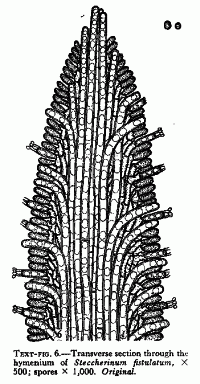|
 Stecchericium seriatum Stecchericium seriatum
SynonymsStecchericium fistulatum
Steccherinum fistulatum
Hydnum seriatum
BiostatusPresent in region - Indigenous. Non endemic
Images (click to enlarge)
Caption: Text fig 6. Transverse section through the hymenium of Steccherinum fistulinum, x 500; spores x 1000. Original. |
Article: Cunningham, G.H. (1958). Hydnaceae of New Zealand. Part I. The pileate genera Beenakia, Dentinum, Hericium, Hydnum, Phellodon and Steccherinum. Transactions of the Royal Society of New Zealand 85(4): 585-601.
Description: Hymenophore annual, membranous, pileate. Pilei effused-reflexed, with broad resupinate
bases, 12-25 mm long, 8-12 mm radius, or applanate when imbricate, 5-30 mm wide, 5-10
mm radius; pileus surface straw colour or pallid tan, finely tomentose, concentrically sulcate
and zoned with bands of hairs of different shades of brown, radiately rugulose; margin
thinning out, plane, entire, somewhat complicate, concolorous. Hymenial surface straw
colour, rough with spines, not creviced. Spines subulate, terete, crowded, 0.5-2.5 mm long.
Context white or straw colour, 0.2-0 5 mm thick, composed of intertwined mainly parallel
hyphae; skeletal hyphae 5-8 µ diameter, walls 0.2 µ thick, hyaline, staining, sparsely septate,
sparsely branched; generative hyphae 3-4.5 µ diameter, walls 0.5-1 µ thick, hyaline, staining,
branched, septate, with clamp connexions. Hymenial layer to 35 µ deep, a dense palisade of
basidia, paraphyses and conducting hyphae. Basidia subclavate, 10-16 x 3.5-4 µ, 4-spored;
sterigmata slender, erect, to 3 µ long. Paraphyses subclavate, 8-12 x 3-3.5 µ. Conducting
hyphae arising in the context, traversing spines and forming the bulk of the axial tissues,
cylindrical, 5-8 µ diameter, projecting slightly at spine apices, turning at right angles and
projecting for 50 µ from the hymenial layer of the spines, naked, filled with refractive oily
contents. Spores oval or obovate, 2-2.5 x 1.5-2 µ, walls smooth, hyaline, 0.l µ thick.
Habitat: HABITAT: Usually imbricate on bark of dead stems and stumps.
Distribution: DISTRIBUTION: Queensland, New Zealand
Notes: An unusual feature which enables the species to be recognized readily is the presence of
conducting hyphae, containing refractive contents and oil drops, a feature not noted in any
other species of Steccherinum. A second is the small size of the spores, which do not exceed
2.5 µ in length, and are difficult to see unless thin sections are prepared and adequately
stained. Surface features resemble those of S. ochraceum, and in fact one collection was so
named by C.G.Lloyd. Skeletal hyphae are thin-walled and form the conducting hyphae; walls
of the generative hyphae are relatively thick in hyphae of the context (though thin-walled in
the sub-hymenium) the converse of what is usually found in species with a dimitic hyphal
system. Hyphae stain deeply in aniline blue.
|